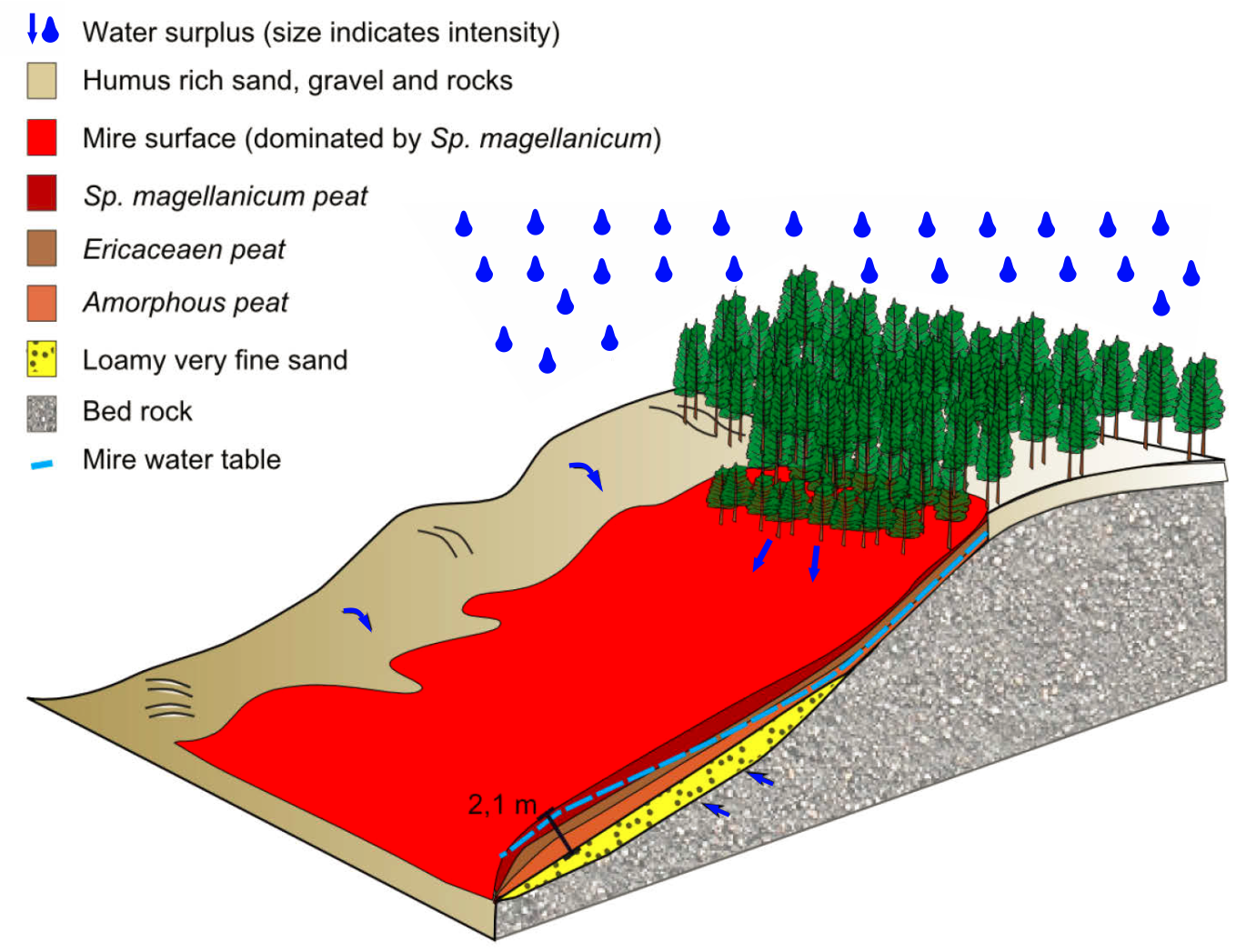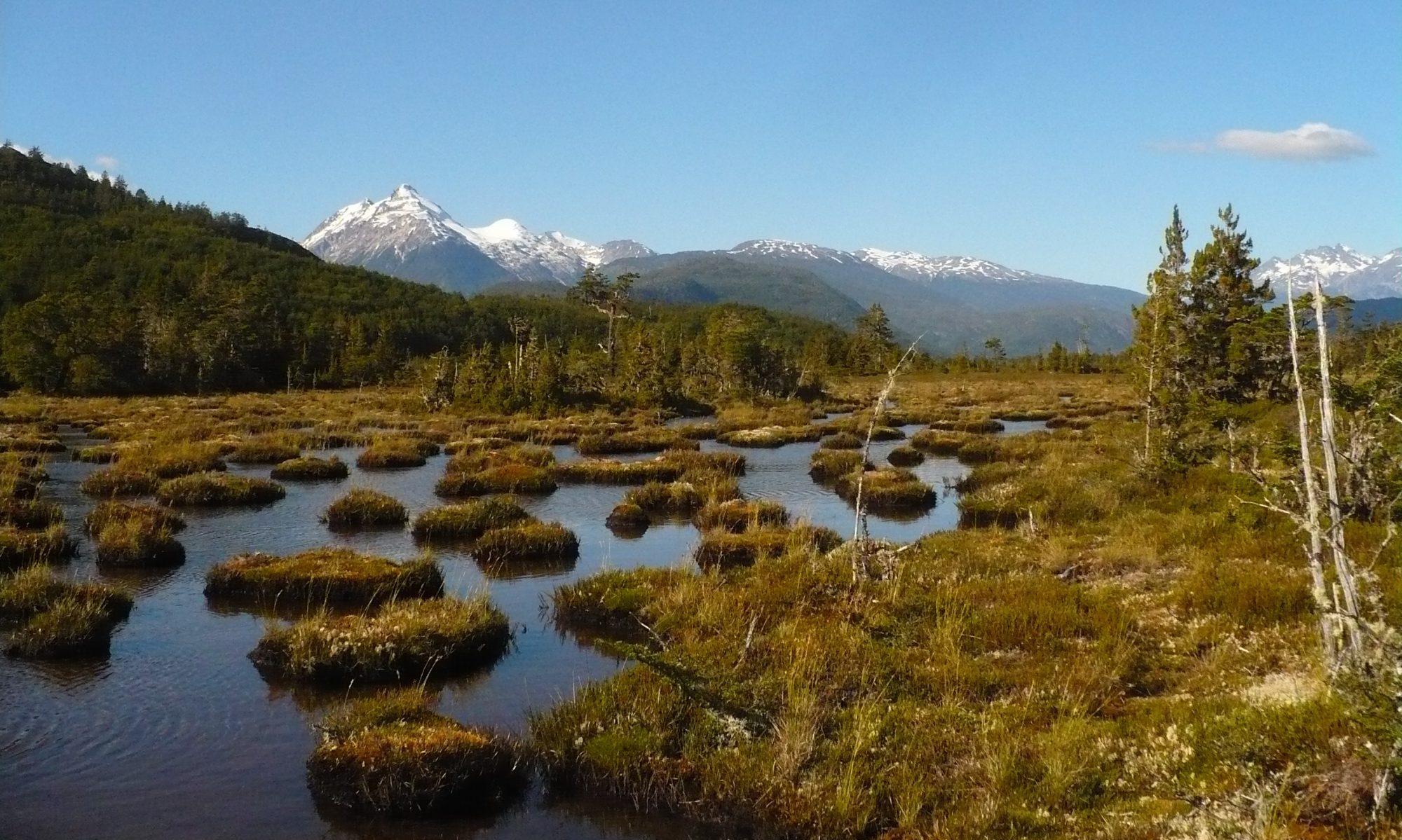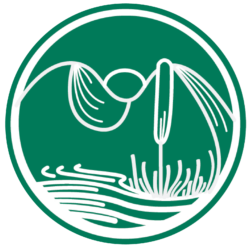Sloping mires presenting minerotrophic conditions are reported in Germany (Jensen, 1961), in the U.S.A. (Chadde et al., 1998), in South Africa (Ollis et al., 2013) and are also present in Kyrgyzstan (own observations). In comparison, considering the vegetation and domed form of sloping bogs in the Chilean Patagonia (where they are most common), these present a current ombrogenic development. As their name indicates, sloping bogs grow presenting 3% to 9% inclination, and are common in sub-mountain and low alpine sectors of the southern Cordillera de los Andes . The current peat forming layer is mainly moistened by rainfall, presenting a convex morphology elevated from the landscape level. Sloping bogs originated in soils moistened by percolation waters, but their current peat formation is influenced principally by rainwater.
Current vegetation
The vegetation is distributed in a water level gradient in sloping mires. The well drained upper area is normally colonized by Sp. magellanicum flat carpets, sometimes forest-covered by Nothofagus dombeyi and Pilgerodendron uviferum trees, where also the specie Lycopodium magellanicum and Lepidothamnus fonkii can be found. On the downward slope the trees diminish and are replaced by shrubs of Empetrum rubrum, which can adapt to fluctuating saturated and dry conditions. The lower part of the slope is usually colonized by ombrogenic adapted rushes and sedges such as Marsippospermum grandiflorum and Carex magellanica. In the saturated lowest areas, patches of Sp. magellanicum and Astelia pumila associated with Donatia fascicularis can prevail. In other words, sloping bogs are forest-covered on their upper part, becoming raised bogs in their central-lower part where cushions of Sp. magellanicum, C. magellanica and M. grandiflorum prevail and finishing in blankets of cushion plants such as A. pumila and D. fascicularis on their lower part.
Hydrology
Sloping bogs originate in soils wetted by a mix of rainfall and percolation waters. Whilst rainfall is the main water source feeding the current peat forming layer in sloping bogs (i.e. the acrotelm), percolation water flowing laterally from the sides and upper part of the slope, influences the peat horizons underneath. Percolation inputs entering into a sloping bog are composed largely by rainfall. The high rainfall also infiltrates and moves through the soil vertically. Thus, the influence of the mineralized inputs in the forming peat layers is almost neutralized. Additionally, sloping mires present a domed shape, practically forming the raised bogs of the inclined areas, differing from these in the chemical and physical conditions of the peat layers underneath, which are more decomposed and thinner. According to the mire water level variation sloping mires tend to be forest-covered in their upper part and flooded in their lower part. The water level increases on the downward slope, allowing a higher peat accumulation and thickness in the lower areas than in the upper areas, and at the same time the development of trees is hindered. A simplified and stereotypical schema of a sloping bog is shown as follows

Substrate types and Stratigraphy
Sloping bogs present a characteristic stratigraphy of an ombrogenic peat horizon above geogenic peat, all lying over a mineral parent material of coarse to fine sized sand and loamy sand. Namely, sloping bogs are secondary ecosystems. Considering their small size, sloping bogs occur as mires with diversified substrates, reflecting an adaptation to different water surpluses and different nutrient levels. Therefore, there are characteristic substrate types forming the sloping mires. Among the ombrogenic peat types (peat formed in mires fed by rain water), the most common are Sphagnum magellanicum peat, Ericaceae peat, Oreobolus peat and cypress wood peat. The geogenic peat types (peat formed in mires fed by mineralized water) most common in sloping mires are amorphous peat and radicels peat. An increment of Ericaceae peat was observed in sloping mires compared to raised bogs. According to soil cores extracted in sloping bogs of Aysén and Magallanes, it could be confirmed that the peat accumulation occurs in thin horizons along the mire, increasing in thickness on the downward slope. This implies different chemical and physical conditions in the under layers, corroborating percolation processes through the mire. On the other hand, considering all the horizons encountered in the sloping mires, these ecosystems present a median pH-value of 4.1±0.6, covering a spectrum from 2.3 to 5.3. For more information, review the document Substrate types in mires of Aysén: a tool for their recognition.
References:
Chadde, S. W.; Shelly, J. S.; Bursik, R. J.; Moseley, R. K.; Evenden, A. G.; Mantas, M. et al. (1998): Peatlands on National Forests of the Northern Rocky Mountains: Ecology and Conservation. General Technical Report RMRS-GTR-11. Edited by Forest Service of the United States Department of Agriculture. Rocky Mountain Research Station. Utha, USA, 80 pp.
Jensen, U. (1961): Die Vegetation des Sonnenberger Moores im Oberharz und ihre ökologischen Bedingungen. 1st ed. Hannover: Niedersachsen Verwaltungsamtes Naturschutz, 85 pp.
Ollis, D.; Snaddon, K.; Job, N.; Mbona, N. (2013): Classification system for wetlands and other aquatic ecosystems in South Africa. User manual: inland systems (SANBI biodiversity series, 22), Pretoria: South African National Biodiversity Institute, 124 pp.


